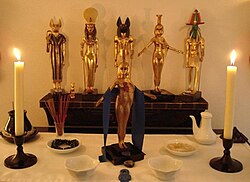
Back كيميتية Arabic كيميتيه ARZ Kemetizm Azerbaijani কেমেত ধর্ম Bengali/Bangla Kemetismus Czech Kemetisme Danish Kemetismus German Kemetismo Spanish Kemetismo Basque Kemetismi Finnish
This article has multiple issues. Please help improve it or discuss these issues on the talk page. (Learn how and when to remove these messages)
|

| Part of a series on |
| Ancient Egyptian religion |
|---|
 |
|
|
Kemetism (also Kemeticism; sometimes referred to as Neterism from netjer "god"), or Kemetic paganism, is a neopagan religion and revival of the ancient Egyptian religion, emerging during the 1970s. A Kemetic or Kemetic pagan is one who follows Kemetism.[1]
There are several main groups, each of which takes a different approach to its beliefs, ranging from eclectic to reconstructionist. These can be divided intro three types: reconstructed Kemetism, a syncretic approach, and the more monotheistic Kemetic Orthodoxy.[2]
- ^ Daugherty, Michelle (2 October 2014). "Kemetism. Ancient Religions in our Modern World". Michigan State University. USA. Archived from the original on 28 February 2018. Retrieved 18 January 2017.
- ^ Harrison, PM (2012). Profane Egyptologists: The Revival and Reconstruction of Ancient Egyptian Religion. UCL (University College London).